 by Wolfgang Werner Köhler
by Wolfgang Werner Köhler
Fellow of Happiness and Ingeneering
Brisbane, 13 January 2008
All links in this paper lead to my sites or Wikipedia.
Most images I collected from the internet, all are from the public domain.
My thanks to all those who uploaded them.
Prologue
The heading informs you about the topic. Still, you start reading, even, contrary to the statement, I hear you loud and clear: “Of course, they can. Look up in the sky. Can’t you see they fly?”
Per definition, something flies when it retains a position in mid-air and remains there for a while, generally combined with movement. I intend to endeavour the attempt to further open your eyes for you to see more and eventually, obtain a more educated point of view.
Why I use the spelling Ingeneer
Undoubtedly, aeroplanes up in the sky have become part of our everyday image of city living. Our ears have become very familiar with their noise and block it out.
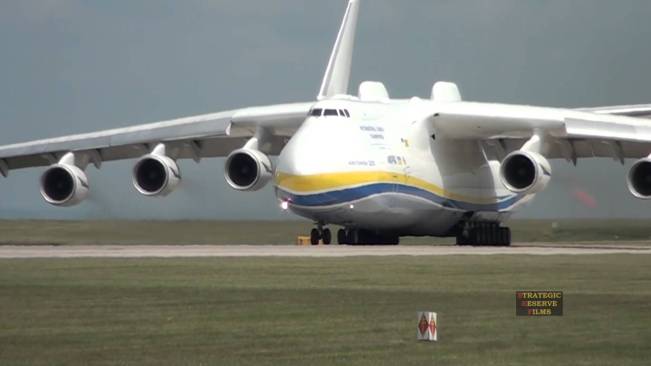
Take a young child to the airport; it will not associate these colossal monsters crouching on the tarmac … picture 1

… with the silver birds elegantly gliding high up through the daily sky… picture 2
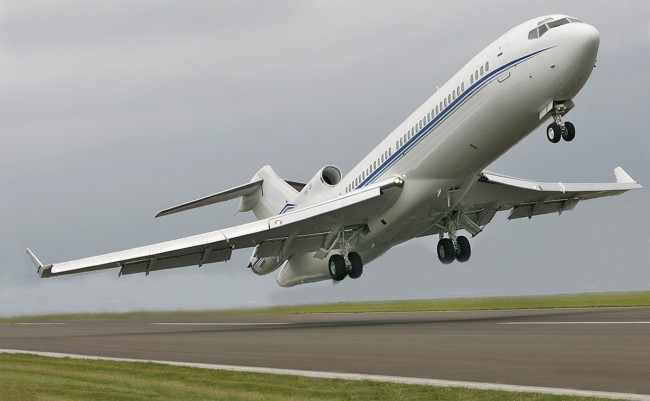
Tell the child about this giant taking off the ground and flying away (picture 3). It would stare at you, unable to believe you.
Now, wait with the child, until one of those monstrous things leaves the ground. The child would express astonishment and disbelief in what it had just observed.
This is a natural reaction, an expression of common sense.
The incessant exposure to the displays of our technological world turned us blasé and made us immune to the innocent question: “Why?”
Science
Before I delve into the subject, let me just quickly clarify several expressions used in the field of science, such as:
A scientific law results from repeated observations of a mechanism or an event in nature, whereby the same action, trigger or stimulus results in the same effect. This consistency entices the observer to think.
Following this, logical deduction (which can vary from person to person) will eventually seed a satisfactory explanation or hypothesis (suggestion of an idea to a broader scientific audience, usually as a written postulate) for the function, thus permitting the prediction of a specific outcome within the same conditions or circumstances.
The more often they have repeated an experiment, and the results have been consistent, the more evidence has been collected. Similar investigations and hypotheses from other fields of science pertaining to this observation supply supporting evidence. Eventually, the hypothesis is accepted.
Accepted by whom? You may rightly ask. Accepted by a prestigious group of scientists residing at the pinnacle of the faculty this new law belongs to. They say it is evident and thus proven to be true, but, who or what makes evidence acceptable?
Who determines after how many trials something is evident? It is a very personal statement, and many follow the peer leaders like sheep because they are afraid to appear stupid. They may not even be able to ask a question.
Ever heard the definition of intelligence? “If you agree with me, you are.” Who would not want to agree with a person acclaimed to be intelligent?
A law in science or physics does not necessarily explain why a process works. Although it is attempted, suggested, hypothesised occasionally, pretending as if all is known. And one of the core rules of science is: “A law is accepted valid (no one asks for the truth) until disproved.”
§
Many laws have come and gone, and even Newton’s laws have obtained a few tethered edges. Especially the one with the apple and gravity. I remember, even at university, we were still fed with outdated information because no one had bothered to rewrite the curriculum, or do not upset the apple cart.
Since it is relevant to this paper, let me clarify: A scientific law is invalidated and discarded by just one contrary fact, and it does not matter how many support it. And sometimes this causes a state of limbo because a new law had not been formulated.
Just another reason why teaching would stick to outdated knowledge because if there is nothing known, there is nothing to teach.
§
Let me also point my pointy fingertip at the word principle, which is often used quite casually in our everyday language. According to the rules of science, a finding is called a principle when it explains and contains mathematical equations and proof.
Observations with no explanations but plenty of assumptions and philosophical discussions (No one knows) is called a natural phenomenon. There are threadbare explanations of something we would like to explain. We believe, we can make rational deductions, but really, we have no understanding.
By the way, jet propulsion is one of those phenomena among the more prestigious such as magnetism, electricity, and gravity and last but not least life itself. You are surprised because they are so much part of our daily life? When will we dare call them miracles?

Picture 4 shows the propeller (top part, dark grey) and director (shinier, larger diameter, below) of a small jet engine, the compression section. It fits in four fists held together. When I look at the shapes, I get all excited, I get goosebumps.
I have worked in this field, where we developed turbines as small as half of my hand. It is all trial and error. After a while, one gets a sense for it. One can feel it but not explain it. All your colleagues are pretty odd. When can we call this a miracle?
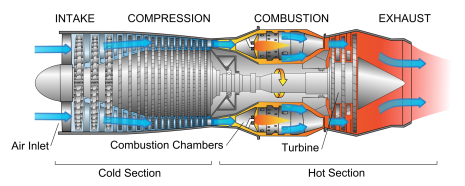
This is an engine for a large, fast-flying aircraft. You can see where the small compressor parts from picture 4 are located. They would replace the compression section, which in the engine, picture 5, takes up half the size of the complete jet engine.
That’s what a big one looks when attached to an aircraft. At the end where the people are you can see the enormous intake and the compressor. It is short and has a wider diameter than the one in picture 5. It is about 3 to 4 times bigger in diameter than a human. That cone on the right side of the photo is deep purple from the cyclic heating to 1900º Celsius. Is this a miracle?
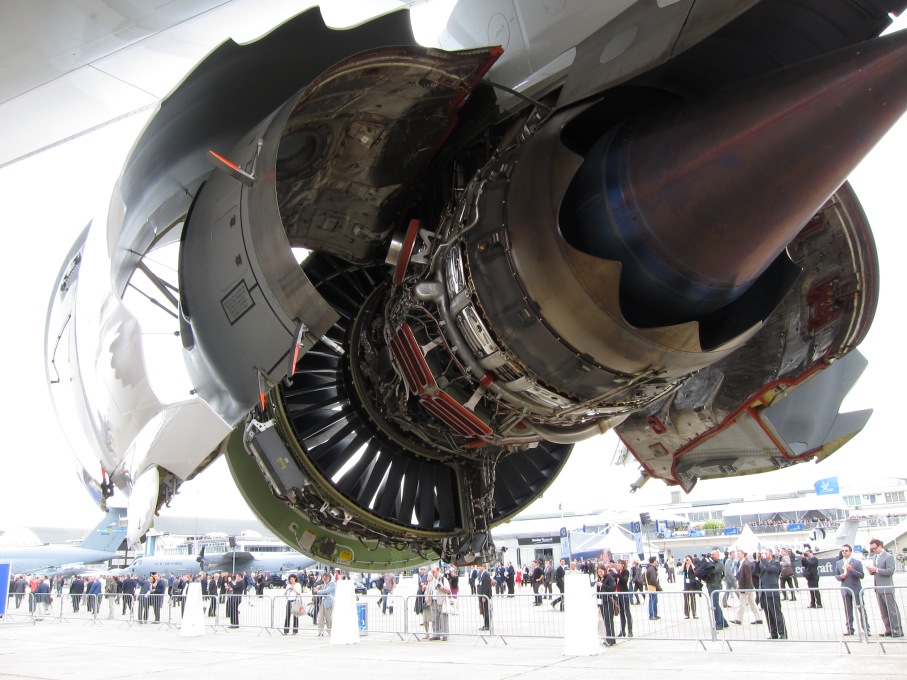
I love to be surrounded by miracles. I love the feeling.
§
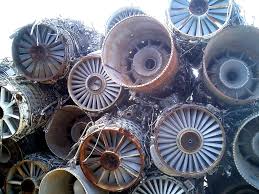
Unfortunately, there is another side to jet engines. They all end up at the wreckers. They pile up there because no one knows what to do with them. Due to the manufacturing methods, it is too expensive to recycle them. What is the cost of the future? The life of our children?
Jet engines have a lifespan of around 15,000 hours. Then they need to be replaced, ditched. During its life of approx 25 years, an aircraft receives about 4 new (not overhauled) sets of jet engines.
More important than actual flight hours are the cycles, the number of trips, start, take-off and landing. A jet engine aircraft lasts for about 10.000 to 12.000 cycles.
Putting it into practical terms: Your car engine… if you drive 100,000 km at an average speed of 80 km/h, (city and freeway), the engine runs for 1250 hours. If your engine lasts for 250,000 km, it will equate to 3125 hours.
Jet engines last about 5 times longer. Why don’t we have jet engines in our cars or at least use a similar materials technology? Excellent question.
Humans don’t Fly
Let us remember for a moment: Until only a hundred and a few years ago mostly birds, insects and clouds occupied the airspace. During the odd four million years of human existence, before this fraction of time we live in at the moment, air dwellers were bothered by human beings only when they would have propelled the occasional stone, lance or arrow through the air.
Sometimes, they would practise, but mostly the intention was to kill an animal for various reasons or to kill another human being, whom they considered an enemy.

Hardly ever, human beings would take both feet off the ground simultaneously, except for some milliseconds when jumping for joy or fear, when dancing or crossing a creek. More extended periods of airborne time would occur involuntarily, only when a person would fall off a tree or the edge of a cliff.
And after impact with the ground, they were either significantly injured or dead. For most onlookers, those results were not the least inviting to be repeated. In the state the air traveller was, no one would want to pose the question to him, of whether he thought humans can or should fly or not.
History tells us only about a few who tried flying with technical support. There was the father and son team Icarus and Daedalus in ancient Greek times (picture 8) and later, in the sixteen hundred, the Tailor of Regensburg.
All tried to imitate bird’s fly with flapping wings, all resulting in fatal consequences.
In the late fourteen’s century, Leonardo explored the flight and anatomy of birds and bats very extensively. He devised several flappers and hoppers and other quite hazardously looking man-powered flying apparatii.
However, we don’t know whether they have been built or tried out. And if, I am not aware of Leonardo writing about them not working or what happened to the test pilot. He is often acclaimed as the inventor of the helicopter.
I don’t think, he ever tried on his contraptions himself. One could conclude: He was too intelligent.

Never mind. Eventually, he drew some very promising gliders with fixed wings.
It took 400 years before Otto Lilienthal took up the idea of the fixed-wing glider, built and tested it, himself, picture 9.
He was the first, who considered attaching a motor with a propeller on a glider. However, he could not carry it out. He got killed on an ordinary test flight. No one knows, what went wrong.
Without a doubt, there have been shamans, sorcerers or other people, who, believing in their supernatural powers tried to fly, using mind-altering drugs or other methods. Records of such events are unheard of. Maybe we have not been told.
Inevitably, this means, it has not been an everyday activity, or if, it certainly contributed toward the extinction of those who were practising flying and the like. Otherwise, we would know about it and maybe would fly ourselves, today.
Nevertheless, many things considered impossible in days of old are today part of our life; things, not regarded as being special at all. Time‑travel a person from one hundred years ago into today’s world and they would point out to you all the things they see and deem them as miracles.
Flying a miracle? Think again. Just time travel 200 years into the future, and you will see miracles, plentiful.
At this point, I rest my case by stating: Human beings can’t fly!
Should Humans Fly?
… could be the next sensible question. If humans were meant to fly, why were they not created this way? It would not have been such a big thing. Other animals can and in reference to its physical construction, our body is based on animal technology. The study of animal life on Earth reports: Animals used to be taller and humanoids smaller, much smaller.
Try to envisage a goose or an albatross being twice their current size, and us, half of what we are. Next, see how the image of winged humans becomes quite acceptable, wings of any kind as a matter of fact. But we have none. Would this mean we should not fly?
Imagine the Timeline of Evolution and let us go into one of those interglacial periods (when we had global warming!) and see what was going on at the time. The dinosaurs had long gone, but there were plenty of other vicious, fast and powerful animals around to whom a few of our predecessors would have served well for breakfast.
If it were for the survival of the fittest, can you tell me why this small monkey‑like creature did not get extinct but survived, while most of the strong ones disappeared? Perhaps those midges had survival skills we don’t know of, today? It may have not been visible in their bone structure, or maybe it is, but we don’t know what to look for.
Let us strain our imagination a bit more. Here is a scenario. Our interglacial homo (more‑or‑less‑semi)‑erectus sits next to a tree and digs with a stick in the ground for some tasty morels. He is wholly occupied with his job, anxious to taste their succulent flavour. It presents a perfect prey for the sabre tiger lurking in the nearby bushes.
The time is right, the tiger leaps, the kill is inevitable, and suddenly the midget is gone, the tiger knocks himself out when he hits the tree. What had happened?
Can we stretch our minds a bit further? Let’s assume, it had some, what we would call today, supernatural powers. What does this really mean? Supernatural. Permit me to elaborate: they are powers beyond our contemporary nature, the range of abilities we currently possess. Someone said, HE could walk on water, and millions still believe it today.
Can you walk on water? I can’t. I know because I have tried. Have you? What if someone would come and show us? Is seeing … believing? Could we walk on water in the distant past? Is doubt our biggest hurdle, which prevents us from achieving what we want? Would you like to walk on water or fly with your own powers? Don’t be ridiculous… I hear you say.
Children believe it. And many of us had and may still have flying dreams. May I ask, why can we imagine it, and even more: feel it in our dreams? Does it feel unreal?
No, and even after the dream is over, we still relish the moments of soaring weightlessly through the sky, swishing around the trees and playing with birds in mid-air. How would we know, what it feels like?
Have you ever told a friend about your flying dreams? And were they not eagerly nodding and were they not describing similar feelings and situations? How is this possible? Had we all, once, long long ago, been able to … Just wait a minute.
Evidence reaches from dream-time stories to fantasy and science fiction movies when we see human beings with supernatural abilities, and they seem to be always the same abilities.
Ancient History
While I was searching and researching for this paper, I found intriguing information… on the net. Some of you may think that I am inclined to believe these pictures because I am a romantic, some may accept the presenters and my interpretation. Even thou, I respect the effort of someone with imagination and the drive to produce them.




These pictures (10 – 13) speak for themselves. It is entirely up to you, whether you accept them or not. For the final outcome of this paper, it does not matter.
It appears that flying has been around in the past. Two of the apparatuses look like contemporary attempts; however, none of them uses propellers, but some other type of propulsion.
I assume strongly, that the Indian and European devices apply some gravity reduction technologies. They must be somewhat hovering and slow flying, since there is no evidence of any protection for the passenger/s, nor do they show any forms of aerodynamics.
Seeing into the Future from the Past
How did our not-so-distant predecessors see the future, their future in which we live today or even have surpassed? Did we achieve their visions? Did we fulfil their dreams?

The apparatus in picture 14 has no resemblance to an aeroplane. It depicts batwings, flapping, probably, a fishtail to steer and a corkscrew for propulsion. I will talk about this suggestion later, in the technical section.

This laboratory contraption in picture 15 was shown in Scientific American in New York around 1860. However, something funny tells me that it is a hoax. Perhaps it was published to ridicule the connotation of flying. Interestingly, around 1925, Nikola Tesla showed a drawing about the principle of anti-gravity of a similar shape.

Picture 16 shows a postcard printed around 1900, advertising “Hildebrand’s German Chocolate” and the inscription on the wing of the casually smoking gentleman says German Cacao. The caption at the bottom tells us about Flying Machines in the Year 2000.
There is a family on a flying surfboard and a smart-looking gentleman’s apparatus with some mechanism, which drives a propeller near his feet.
Most intriguing is the lady’s machine. It does not seem to have any propulsion, except, that the wings were meant to flap, and I wonder what purpose the horn-shaped protrusion at the front was all about. This is no random whim, below the gentleman, in the background, is another one of those horned machines.
However, the most remarkable is the lady’s sexually enticing outfit. Trousers for women alluring that their legs end up somewhere up there, how obscene, in 1900.
Hildebrand’s had a whole series of postcards describing the world in the year 2000. Water walking machines, a good weather machine seemingly applying orgone energy, moving houses and moving footpaths, a machine that makes clothes while you wait, below the sea boats with glass walls and lights and last, a telephone with vision.
§
In summary for our sojourn into these long-distance and short trips into the past: How did all these machines work? I do not believe that our ancestors just made things up for the purpose of confusing us. We don’t do it now. Most of us don’t often think of our descendants when we speculate about the future but try to be convincing with ideas based on contemporary science.
In one form or another, these ancient artefacts were part of their reality. Science eradicated these facts, called them witchcraft, illusion or magic. And now, we don’t know.
Yes, there were aeroplane-shaped apparatii around, and most of them used other propelling techniques than propellers. However, the most convincing images show machines, which, from our ancestors’ point of view, were more acceptable to fly than what is in the air today.
Supernatural
Let me mention some of them to refresh your memory. All the old cultures around the planet certify the existence of one supernatural power: Fortune telling. They mean by this: Someone can predict what will happen in the future. The oldest Chinese book has survived two burnings of traditional literature, of which the first was ordered by the Yellow Emperor, in 2500 BC and the other by Mao Zedong, in 1949 – 76.
I am talking about the I Ging, 易經 or The Book of Change, a reference book for fortune-tellers used in their counsel for over three thousand years and more. It is a collection of knowledge compiled over a period of many thousands of years before.
Shape‑shifting is another, typical (?) supernatural ability when a person changes his appearance usually into one of an animal. Involuntarily this is the case with the werewolf. And the shamans around the world of the likes of Don Juan, who turns himself into an eagle with the help of mescal buttons from the peyote cactus.
And there are well-known witches and wizards who put spells on the princes and turn them into frogs or lovers into swans (Swan Lake).
§
More recently we know of Mister Clyde who can make himself invisible, followed by Superman and people emitting killer rays from fingertips or from eyes. Then there is all this teleportation and telekinesis when one uses the power of the mind to imply forces onto an object or person in order to move them, visibly or via de- and re-materialisation, or telepathy, communication without words.
There are the Stargate and the epic of a future world with the unfortunate name of Star Wars. Can it be more realistic than this? Super-naturalistic examples have been always around and always the same, for quite a long time.
Why the repetition and why not any new ideas? Is it because our imagination is triggered by some forgotten knowledge?
Maybe, could we accept the wild imagination of Mister Midget (our interglacial predecessor) having utilised some of those tricks to get him out of peril? A bit of seeing into the future and a bit of teleportation and up he was sitting high up in a tree, giggling with a few pixies over the clumsy sabre tiger.
This is another one, the pixies were mentioned in many cultures; they had been around until fairly recently. I can see you, even without supernatural powers, formulate the next question. “How come, we have lost these skills?” May I remind you, that some of us still have them, and some of us claim to have them?
You may have heard of a mysterious gland they discovered inside the dolphin’s forehead, at the place, which is often referred to as the third eye (where does this expression originate from?). Using an unknown power, dolphins can stun a fish within a distance of four metres, and they can catch it more efficiently.
You may think that all the above-mentioned supernatural abilities stem from Central European lore of the dark ages. Sure, but they have their parallels with much younger evidence on the other side of this planet.
§

Therefore, allow me to digress for a moment, returning to China and talk about the philosophy of Tao, meaning The Path. Its origins go back to four hundred years B.C. to its legendary founder Lao Tsu meaning Old Master. At the end of his life, he wrote a book called the Tao Te Ging meaning The Path of Change.

Much has been said about Tao philosophy. What I want to refer to are the stories being told about Taoist masters, long before philosophers had turned them into Taoism, a religion.
These masters were able to ride the wind or on clouds, could appear and disappear at will, had extremely long lives, did not eat at all, were invulnerable and could repel or kill their enemies without even touching them.
Here we have at least three similarities, in particular, the one about flying. And it happened only a bit more than two thousand years ago. Can this be considered evidence? It is written. Historians accept and believe what the old Egyptians (3000 BC) and Sumer (5000 BC) wrote.
§
The Hopi Indians of North America tell about the Children of the Feather and the Children of the Lizard both of which could fly, disappear at will and have superhuman strength, and they could handle unknown energies and cause all kinds of magical events.
Sioux Indian mythology tells us about glowing human beings riding on hovering tree logs through the forests and canoes floating through the air, beings who could help people from separate tribes speaking different languages understand each other.
What conclusion can we draw from this information? If there are two large cultures on the opposite side of our planet who come up with the same range of supernatural abilities, there could be other cultures with similar stories.
But even if this is not the case, still there is enough validity to the question: “Where would this similarity eventuate from.” And certainly, one plausible answer is: “Their individual ancestors must have possessed such powers, once .”
Brain Capacity
Allow me to relate one of my childhood stories. It was at school, which grade I can’t remember but the fascinating subject was human anatomy. Interestingly enough, the last thing we were introduced to was not about how the bumblebees and the butterflies and the fish and the mice and the cats do it but about the brain. And one snippet of information stuck in my mind, forever. (Teachers, heed your words.)

He told us, that the brain’s thinking ability, the mind, was located on the brain’s surface. He continued, that we would not have the biggest brain but the one with the largest surface area. He kept on explaining, this was achieved through the brain having a corrugated surface.
So far so good, but to my surprise he revealed, that we use only about ten per cent of it. Even, still, at a young age, I was deeply stirred up by this information. Since I had not learned deductive thinking, my protective subconsciousness moved this unsettling thought into one of the corners of my mind.
When I mention this ten per cent bit, usually people seem to get hung up on this number, but really it does not matter whether eight or fifteen per cent, it is still only a fraction of the total capacity. Albert, who was apparently the only one of all known human beings (since we know about this stuff) had the highest usage of the brain’s capacity. I heard it was about thirteen per cent.
Next to much else, he had some significant information about this topic, too, and therefore, for a moment, I leave the stage to him. He said about a particular type of people: “It was a mistake when they received their cerebrum because for their style of unconscious living the spinal cord would have been quite sufficient.”
§
Anyhow… this restless thought about the ten per cent pops up every now and then, testing me, to whether I had matured enough and was ready to digest it and explore it on my own. In my late teens, I learned more. At that time I favoured the path of Darwin’s evolution theory.
I began to wonder, why, if we never had any use for it, why would we have developed such a large brain? Isn’t the reason for evolution having something, a preceded need? Something needed to survive? Those with a more extensive brain capacity would survive, and those with lower would be extinct.
Why develop it, if there is no use for it? And isn’t it funny, today we think, we are at the pinnacle of human development? Why would the abilities we had, the reason for having such a big brain, suddenly disappear?
If evolution is true (survival of the fittest), today, we should have the largest brain capacity ever and would use all of it, to its brink. Further human evolution should push steadily at its boundaries forcing the brain’s capacity to expand. But evidently, this is not the case.
Thus I concluded: At some time in the past, we must have been at a higher evolutionary level, a time when we used our total brain capacity when our mental development actually was still pushing to enlarge our brain. And then, it stopped. Why?
Perhaps my concept of the fittest is wrong. I believed that mental fitness surpasses physical fitness. Looking at the cultural decline of Western civilisation demonstrates my error.
§
I admit, there is a weak spot in my deduction. Did you notice it? How do we know, how much of the brain we use? We measure brain activity, while the owner of this brain is exposed to various situations and actions. We have learned what happens at which location.
We ended up with a map of the mind with areas where the stimuli did not cause any brain activity. We don’t know, what these sections are for. We measured activity and don’t know, what instigated them. Finally, there are sections where no activity was ever measured. I did not say: “… did not occur”.
The problem is: We only measure criteria when we are aware of their existence or at least when we suspect they could exist. We need to or at least believe to know their nature to build a measuring device. And most of the time the result which the measuring device displays is only something correlating with a signal, not the signal itself.
Allow me: Magnetism has been around since the early settlement of galactic vapour, which produced our planet. For billions of years, it existed, without anyone knowing. How do we know, today, that it existed then? Magnetism has influenced the growth of trees and crystals. Geologists find samples and (believe, they can) date them.
An Italian sailor, from lovely Amalfi, is claimed to have discovered the magnetic compass. Interestingly, within the same decade, the magnetic compass was invented in China, independently.
The compass does not show us magnetism. The movement of the needle is caused by the forces, which magnetism exerts on ferrous objects. And likewise, a clock (man-made) shows us numbers that represent the flow of time (man-made?). It does not make time tangible, nor does it prove its existence.
Returning to the brain: Maybe, something is going on in those uncharted parts of the brain. These unknown activities produce signals, we cannot measure, yet, because we know nothing of their nature. This does not mean, the brain does not emit any signals; we just have no awareness of them.
The Japanese koan goes: “If a tree in the forest has fallen and no one was there, does this mean, the tree has not fallen?”
Wizards
For the time being, let us assume, for lack of knowing better, at some point in the past, we used all of our brain’s capacity and were able to perform many incredible things and most probably even more unimaginable ones.
What could they have been? Of course, all the abilities I mentioned before, clairvoyance, shape-shifting, tele… this and tele… that and what more? Were we all wizards? Just stay here, don’t think of an answer. Remain in this dream before you read on… Nice, isn’t it?
I would like to introduce you to an etymological suggestion. Wizard… wiz – ard. If we allow for a different, free and uncensored way of spelling, we could arrive at wise – art, the art of wisdom.
§
Now, gently, let’s return to harsh reality. What has caused the end of this magic era? Why can we not access all parts of the brain any longer? The saying goes: “If you don’t use it you lose it.”
Ok, but why have we stopped using them? Have we forgotten, that we had once those abilities? Obviously, but what made us forget? This question seems to aim at something outside the mind, a control outside our range.
This trend towards superficiality is part of humans’ innate nature. Quite possibly, this could be the cause of the decline in brain usage. An example of this decline is reflected in our society.
§
Two, three thousand years ago, in the time of Aristoteles, Socrates, Diogenes and my friend Democritus, not the amount of money owned determined a person’s position in society but their ability to think. Today, it is easy to see, how very little thinking is valued today.
More recently, Mr Chrysler (motorcars) said: “In an ideal world, the best of us would be teachers, and the rest, would need to settle for less.”
In my lifetime only, I have observed the change in academic teaching and learning, having been on both ends, teaching and learning. In this context let me refer to the word to study stemming from the Latin studere meaning to desire or to be eager for or to strive or to make an effort.
From the curriculum, we knew what was on for a lecture. We had to search for the information (in libraries and books!) and be ready. Afterwards, we had to decipher our scribbles taken during the lecture (no lecture notes were handed out!) and determine what was to be learned.
We met in groups, where one of the best, a more senior student would volunteer to guide us in the right direction. Tutoring was considered an honour and part of an academic tradition.
Only two to five per cent would complete their studies with a degree. Mind you, in those days, even with a partial degree, one would still gain higher-ranking employment.
Today, things have changed, and teaching is targeted toward mediocrity. Indubitably, there are talented students today, however, for talent to be evoked, it needs challenges, above average.
If we can see such a decline over a fifty years period, imagine how knowledge and ability could have fallen into oblivion over a span of twenty thousand years (end of the stone age). And further, the witches’ hunt was only six hundred years ago, equal to one hundred fifty generations, which I see as the end of widespread conscious alchemy and purposeful magic.
With all other things being equal, we all have a choice between either striving for the as-good-as-possible, which is an ongoing process or conceding to the mundane as-good-as-necessary, uncaring attitude.
§

Were we all wizards? As much as I would like to delve into this topic, I choose not to enter this realm. This could be the place where a fantasy novel could begin. When there was a time of freedom where we could relive our forgotten past with excitement, without the condemning pointed finger of less imaginative critics.
In picture 20 a wizard talks to his servant animal. It is painted on the fragment of a Greek pot. I would have liked to show a picture of a contemporary wizard or a witch, but stereotyping is so strong. I was looking for someone, like you or me, only with this bit extra.
Oh, I can’t stop yet. Have you noticed, that often we talk about a point in time, like if it is a place, a location, or locations in between which one can travel? Time travel… no doubt, this was one of our lost abilities.
I am confident; this was the way we were meant to fly, not with wings but with our minds’ forces, hopping through the galaxies without any delay… or not? Would this not be the appropriate way of moving around for beings, someone once euphorically called the crown of creation?
Why would the creator at the end of HIS/HER work, create something of lesser perfection than all the previous creations? Creations, where SHE/HE tried out all thinkable methods of walking, crawling, swimming and whatnot, and last, flying. After all this, why would HE/SHE choose a solution inferior to those, tested previously?
Appears entirely nonsensical to me, but again, I am only human, after all.
§
Did you enjoy our temporary sojourn into the age of the completely active brain? Now, returning to aeroplanes sounds almost a bit deflating, however, let’s soldier on.
To See or Not to See
Adhering to the generally accepted rule: “We see them; therefore, they exist.” I have to admit, aeroplanes are in the air. Nevertheless, I would like to shed some light on this, on seeing I mean.

Imagine two friends watching the traffic. One is interested in green sports cars. I guess, he must be Italian. Excitedly, he points out to his friend: “Wow. Look at this green car over there?” The other, watching the boys playing soccer/football, was not aware of it.
Would this mean, the green car does not exist? Surely not. What we see is influenced by what we know, are interested in or scared of. If not noticing something does not prove its non‑existence, can seeing something validate its existence?
Listen to our two friends when they meet again. “Yesterday, I saw you running across the street, near the station, at half-past three. You must have been in a hurry, what were you up to?” The other one looks dumbfounded. “I was at work all day.”
What had the friend seen? An illusion, for sure not, someone else probably, but this was not what he thought. It was not what he believed, and therefore, for him and his reality, his friend was running across the street. This much about seeing.
For argument’s sake, let’s assume aeroplanes exist and they can move through the air.
§
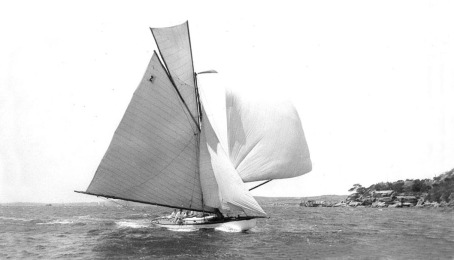
To progress with this subject, I would like to look at air and the forces it can exert on objects. There are two ways; one is through the force of buoyancy, like when it lifts a dust particle, a hot air balloon, or a blimp, a zeppelin. The other way comes in the form of wind when this force is applied to the sail of a windmill, a sailing boat or a kite.
In all cases, the size of the objects hovering due to buoyancy or the sails being filled by wind is much larger than the load. One could remark, that the forces of wind are not very efficient; they easily spill out of the sail, and therefore it must be adequately large.
When we talk about buoyancy, we generally refer to objects floating on water where they usually don’t sink because under this condition they are weightless; their weight is compensated by an equal force lifting it, namely buoyancy. You may have noticed, that a boat with a load sinks deeper into the water than an empty one.
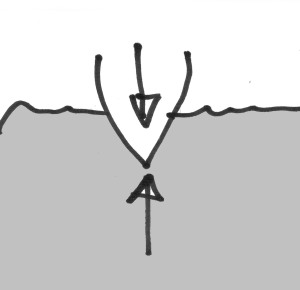
Archimedes (287-212 BC) discovered this Law of Buoyancy, allegedly, when he was sitting in a bathtub. Before he stepped into the tub, it was filled with water up to the brim. When he climbed into the tub and while settling down, copious amounts of water spilt over the rim, and he felt lighter. For millennia, people had noticed this, but he was the first who thought about it and came up with the concept of the displaced fluid.
By the way, still today, this method is used to determine the volume of an irregularly shaped body. You simply place such a body into a vessel, completely filled with water or any other fluid and you collect the spillage into a measuring container.
This concept of displaced fluid was the instigating clue, which led to the law: “A body immersed in a fluid is buoyed up by a force equal to the weight of the displaced fluid.”
Fans and Propellers

Let us continue. As we all know, wind blows because of the meteorological, thermodynamic forces in the air around our planet, the atmosphere.
We feel wind because vast sections of air volume move at speed and direction different to the constant rotation of the earth, thus the ground. Wind blows across a vast region. Excellent for sailing ships and windmills.
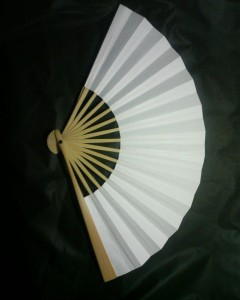
We also can make wind as we have learned it from birds. In the early days, it was the small silk fan in the hand of an échaufféd lady, which created a refreshing flow of air or a slave used one a bit bigger, to create more airflow and thus more cooling and they were often adorned with feathers and other dangly things.
Once we learned how to make electric motors (based on laws of electromagnetism, which we still don’t understand) we attached several wings to its rotating shaft and still called it a fan.
However, the forces this type of propeller creates are considerably small in strength as well as in distribution. It may blow away a loose leaf of paper from your desk. The fan does not blow itself away (but we expect it from aeroplanes), it does not slide the slightest bit because it is too heavy, and everyone knows this.
We have observed, the area covered by this artificial wind is quite limited, and it disperses readily; after a few meters, we can’t feel the breeze any longer.
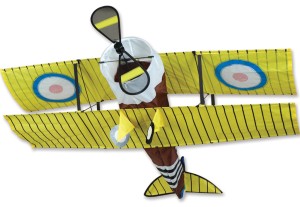
Consider, someone mounting such a motor-driven fan onto a kite and assuming it can make it fly. Who, in their right state of mind, would ever dream of something like this? Would you believe this, if someone would tell you? Surely not. I talk about this later.
Just imagine, if you would make a kite of this size and weight of even a small aircraft, what sort of wind would be required to fly it? Half a tornado at least.
You might argue, a propeller can create quite a high wind speed, sure, but only in a very confined area, just a bit wider than the diameter of the propeller. To fly a kite, the wind covers not only the whole surface of the kite but also the area all around it.
The question is: how large does the propeller or numbers of propellers need to be to cover the whole area of the plane? Substantially larger than the aeroplane itself. Agree? How come we know, a fan can’t blow itself away, but we accept this aeroplane thing can fly even if its propeller size plane weight ratio is much worse? Besides me, does no one else recognise this discrepancy?
Someone suggested a propeller works a bit like a corkscrew when it pulls itself into the cork. This analogy surely works for cork because the cork’s solidity is much higher than that of water, even though its density is only a fifth, (hence, cork floats on water). In comparison with the size of a ship, the ship’s propeller is exceptionally tiny. This combination works because in water the ship is practically weightless, as we know from Mr Archimedes and his buoyancy.
All the propeller has to overcome is the inertia of the mass of the ship, which is pretty big and the friction of the hull in the water, which is very small. It takes time. Gas is about one thousand times thinner than water… or wine if you prefer. Therefore, it provides hardly any buoyancy for the air-ship, and, what makes things worse, the propeller has nothing to grip into.
§
Do you think top technology in modern aircraft is performing better? On the contrary, the situation gets worse. They weigh tonnes (Boeing 747, Jumbo Jet = 454 tonnes). And what is used to propel it? A turbine, sorry, four of them, you think, this is something great, superior, new.
Not really. A turbine is nothing else but a continuous pump, a compressor. It sucks in air, with a set of fans, which gradually reduce in diameter as well as its casing.
And because the outlet is much smaller than the intake and the air volume is constant therefore the airspeed must increase, but unfortunately, its pressure drops (See my explanation of Bernoulli’s law in the next chapter Wings and Flying).
The contradiction is: With the pressure reduced, how can it push more? Don’t ask me; ask them, I believe you will get an irritable response.
Newton talked about his third law of mechanics; “For any force to exist it requires the existence of an opposing force of equal magnitude and opposing direction.” This means it needs something to push against.
The wind pushes against the kite, and if the kite is of a particular design, it lifts up. The wind blowing against the kite’s material can create lift, but the force develops only if you hold the string tight enough to provide a force of equal magnitude and opposing direction. If you let go…
It all makes sense, but if you blow with your fan (propeller or turbine on the aeroplane), the wind blows against air. Not much of an equal opposing force is present at this point in space.
Wings and Flying
Mark’s Standard Handbook for Mechanical Engineers has been around for thirty years and is still held in the hands of (older) ingeneers all over the world. A comment at the beginning:
“The author and publisher will be grateful to readers who notify them of any inaccuracy or significant omission in this book.”
Somewhere later in the introduction, I found the following sentence:
“Designing a wing, powerful enough to lift a plane off the ground, and yet efficient enough to fly at high speeds, is one of the marvels of aircraft technology.”
Call it a marvel or a rose by any other name. Ingeneers get dreamy-eyed when they don’t know what they talk about.
§
Whenever you look up information for why aeroplanes fly you find people talking about wings and air passing over them and underneath and a particular criterion of the wing design, that makes the wing push the aeroplane up, creates a force, called lift and makes it stay in the air.
The lift of a wing can also be explained using Bernoulli’s principle (1700-1782), which relates: “Faster moving fluids (as well as gases) will have a lower pressure than slower-moving fluids having a higher when otherwise in a homogeneous surrounding.”
Since all flying pivots around Bernoulli’s principle, allow me to explain:

Imagine air being made up of strings of pearls and these strings can be stretched. There is the same number of pearls on every string, and they have the same distance, the pearls and the strings. Everything is evenly distributed. Consider this junk of air moving along, like wind. This is called laminar flow.
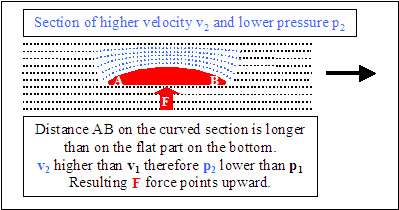
If one places an unsymmetrical shape into this junk of flowing laminar air (wind) nothing happens to the strings of pearls below the shape, picture 28.
However, the distance the pearls of air have to travel on the top is longer, and because they have to meet up with those in the lower part at the end of the profile they have to move faster, and their velocity is higher.
Since there is the same number of pearls on a stretched and therefore longer string, the pearls would be further apart. This is equivalent to the presence of lower air density and lower pressure, subsequently. Yes, the air pressure above is lower than the one below.
Areas of high pressure want to fill up areas of low pressure, like the surface of a quiet lake is always level. If you place an obstacle, the unsymmetrical shape from above, this object will be pushed upwards.
If you puncture a tire, the air wants to escape from the high pressure inside the tire to the outside. If one places an obstacle (a sheet of paper) into this flow, one can feel the pressure exerted on it. The sheet of paper will fly away.
Further away from the unsymmetrical shape, the disturbing influence disappears. This not only applies to air but any other gas as well as fluids.
The definition for those who do not understand (excluding the reader) is:
A wing capable of generating lift is designed in a fashion (bulging on the top) causing the air on the top to flow faster at a lower pressure than the air underneath the wing, which flows slower at higher pressure.
Force, Lift = Pressure difference × Wing area
The force directed upwards is proportional to the pressure difference multiplied by the wing area. This force can elevate the wing including the thing it is attached to if the lift is larger than the item’s weight.
The larger the wing and the higher the speed, the higher the force. I do not dispute this fact.
§
Birds occasionally and bats use the same principle, the principle of the glider. For a few moments permit me to digress and talk about the latter. Gliders use the wind around the wing principle to keep them in the air as long as they move forward; however, they drop ever so gradually.
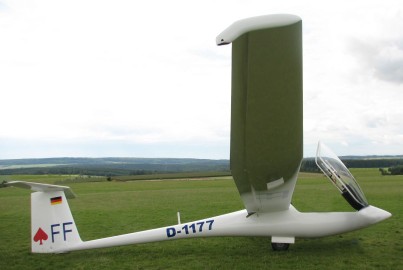
This descent gives them the forward thrust. Mostly, it is their own speed, which makes the wind rush over and under their wings and thus causes Bernoulli’s principle to work. Again, to reduce the amount of falling, they are built extremely lightweight, and they have large wings.
Skilled pilots fly against the wind, which increases the relative wind speed thus the glider ascends. They look for landscape conditions where the wind would rush against and up, as it occurs along cliffs and mountains. They also search for areas of thermals (no connection with underwear) where rising air would lift the glider.
This allows them to stay in the air longer. Without these conditions, the glider’s time of flight is directly proportional to the height it has been dropped off.
§
What I like to point out is the weight-to-wing size ratio, the wind speed and the amount of airflow required to lift motorised planes off the ground and hold them in the air. There is no comparison. According to glider design rules, aeroplanes should not get off the ground and even less, stay in the air.
Let us summarise. The lift produced by the wings of a Jumbo has to be greater than 454 tonnes. Supposedly, if Mr Bernoulli is correct, the pressure difference caused by different wind speeds will produce this lift. And how is this wind speed created?
(PS: I calculated: At a take-off speed of 320 km/h … wing area needs to be 470 m2. It actually is 541.2 m2. Not much of a safety factor. Also, read the next chapter on Eggshells)
The phenomenon of jet propulsion propels aircraft to such speed, and the marvel of wing design keeps them up there. We have to strain two phenomena (things, about which we have no clue) to get them off the ground and keep them up there.
§
By the way, modern science has established beyond any doubt in the mid-nineteen sixties, unanimously:
“Bumblebees and dragonflies can’t fly.” I recommend you would be in good company if you slide a bit closer to my side. In picture 30 I show a bee-wing beating at a cycle of 11.000 per minute… 183 per second. Flies do 62.000 cycles per minute, but they don’t look as cute.

And just to throw in another thought: the flying skills of bumblebees and dragonflies are far superior to those of birds. These clever little insects can not only fly in any direction with incredible acceleration; they also can hover and fly backwards.
Yes, I have seen helicopters; but really, look at them, very clumsy and what a noise about not much. I wonder why modern science got stuck with the birds’ way of flying. Why was there no or not much research on the bumblebees’ and dragonflies’ way? Sure, I forgot, they can’t fly.
Does this not sound a bit childish? And what about this guy Nikolai Tesla? One hundred and fifty years ago he was working on gravity compensation. It is not reducing gravity, (stupid idea) but it reduces the effect it has on the mass of something thus reducing its weight. We can’t change a planet’s gravity… when you look in the wrong direction, you never find what you seek.
Like many of his ideas, such as wireless and lossless electrical energy transmission, supplied and free to everyone around the globe? It disappeared. Where to? (BTW: 80% of the cost of electrical energy, which we pay, is in the price of loss in transmission.)
Eggshells
Let’s leave wings and jet propulsion behind and look at another questionable criterion.

Eggs are relatively fragile, would you not agree? They have an average diameter of about 40 mm. The sickness of an eggshell is approximately 0.6 mm. This equates to a ratio of 1/67.
If we apply the same ratio to the size of a Jumbo fuselage, which has a diameter of about 6.530 m, then, the thickness of the fuselage wall would be 97 mm. This would be very fragile too, agreed? Eggs are, aren’t they?
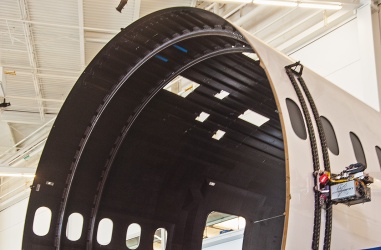
Would it be comforting for you to know, that the average wall thickness of the Jumbo is actually 208 mm? About twice as thick as an eggshell, comparatively speaking. What do you expect would happen if you would throw an egg at 885 km/h? Even with twice its wall thickness? See picture 31 b.
§
Pressurising the cabin would contribute to the stability of the fuselage. Unfortunately, during rising, when strength is needed, they allow the air pressure to drop from that at airport altitude down to an altitude of 2,500 metres over sea-level, or even less. They don’t actually pressurise the cabin, from then on, only, no more air is allowed to escape.
That’s why your ears pop, occasionally. This is because the air in the pockets of your sinus area and ears expand together with all other air pockets inside your body and with the desire to let the increased pressure be released.
Even tiny ones, like in infected teeth, where the expanding gas pushes against the nerve, causing pain. And larger ones in your gastrointestinal areas, the expanding gases look for escapes. Some passengers experience more severe conditions (thrombosis).
This pressure drop in cabin pressure is the cause of jet lag, experienced after long flights. And when the aircraft descends from between 2500 metres to the ground, the air pressure in the cabin increases with it, and this makes 1 out of 3 peoples’ ears pop.
Why do they not maintain a more comfortable air pressure, which would prevent all this? Excellent question.
§
As you know, air gets thinner with increasing altitude and therefore, pressure drops. Air is not weightless. At a cruising height of 11,000 metres, the outside pressure is only about a quarter of the one at ground level.
Like a balloon expands on its way up, the inside gas or hot air pressure applies considerable outward force against the elastic hull. The aircraft fuselage cannot be elastic to such a degree, it needs to be stronger and more stable to keep its shape and the air inside. Stronger walls mean additional weight.
Therefore, they reduce the air pressure inside because it is the pressure difference, which causes the ingeneering problem (and that of jetlag, but they don’t tell us because they don’t want to be held responsible)…
The pressure difference maintained between inside the cabin, and the outside is about 7 psi (50 kPa). If they did not allow the pressure to drop to 2.500 m altitude but keep it at ground level, it would be 24 psi, four times more. The pressure in a car tyre is 30 psi, and a bicycle tyre is from 50 to over 100 psi. Sure, 7 psi is not much at all. A car tyre at 7 psi, we would consider being flat.
Due to the 7 psi change in pressure, the diameter of the Jumbo increases by 3 mm (without pressure drop it would be 10 mm) when it climbs up to cruising altitude. This may be well within the strength limits of the construction.
However, every time, when an aircraft goes through the cycle of rising and landing, the fuselage passes through a cycle of expanding and reducing back to normal. This repeated breathing action causes dynamic stress to the material called fatigue, which causes the material to break after a number of operations. Higher amplitudes of breathing movement would accelerate the cause of fatigue failure.
In confirmation of all this, allow me to post a recent original Boeing press release:
19 July 2010: Boeing launched the 787. Excitedly, they tell us:
“… a plain with the fuselage made from all plastics composite material, reinforced with carbon fibre.
It’s lighter… (and) …it can take a higher inside pressure, which is better for passenger comfort, AND it requires less maintenance because fatigue is minimised.”
They had never talked about this before… but I have, haven’t I?
Concluding: They know why we suffer, but they don’t act on this. Why don’t they? Because the fuselage would need to be thicker, thus heavier by factor four. Aeroplanes would require larger engines and more fuel, which would reduce the profit of airline companies significantly.
They call it payload (the load someone pays for), and this includes us. And if the ratio of the cost of flying and the money recouped from the payload is too small, there is no profit.
§
Knowing all this, I ask you, where does the stability of the fuselage come from? The double eggshell thickness and/or the air pressure? How can we explain this? Is it another miracle? Does it give us another reason why aeroplanes could not fly?
You may have noticed, in the old BIG aircraft, they closed curtains between first, business and economy class during launch and landing?
Ever wondered why? For a long time, I thought, it was because they did not want us to see what was going on in the better section. But being an ingeneer, I was searching for more practical reasons.
It is because the cabin bends and twists and if you were able to look along the full length of the cabin you would notice this. I used the top corner of the aisle seats as a vantage point for aiming. However, there are not many people who would think of this, probably.
It is all for your comfort, would it be disconcerting to you if you would see it? Remember what I said about seeing, or not seeing: “What I don’t see does not exist.”
§
There are a few more aspects, which not necessarily prevent aeroplanes from flying but make their ability questionable.
The design of a modern aircraft like the Jumbo is quite old. It was launched in 1971.
The Boeing 777, a bit smaller than the Jumbo, with only two engines only, had its first flight in 1994.
The Airbus A380, the newest and largest aircraft in the fleets of the world (560 tonnes) had its first flight in 2006.
The technologies applied in those aircraft are similar. The A380 has a newer engine design.
One needs to consider, products such as aeroplanes have a development time of eight to ten years. This means some of their technology is even older. You can’t keep on keeping up with technology; otherwise, you never finish developing.
There is a lot quite old technology flying around, but at least it is proven and reliable, most of the time.
Fuel in Wings
Did you know, they store the fuel (such as the Boeing 767‑400 holds 91.000 litres, 1500 car tanks approx.) inside the wings? This is a relatively modern idea.
In the olden days, tanks were in the rear of the fuselage, and if something happened the plane could still fly, it had its wings. Now, they are gone, off in flames.
In the air force, tanks are generally attached to the plane’s body or the end of the wings, from where they could be dropped off in case of emergency.
Can you tell me why anyone would fill the most crucial part of an aeroplane, needed to keep it in the air, the wings, with petrol? I mean, once the wings are gone, what chances are there to remain in the air or land securely, or in some form?
Undoubtedly, they would have looked into this. Yes, they call it risk assessment. One would think, this would be performed by a group of engineering experts who evaluate the design and make sure all thinkable precautions have been made.
This would be carried out to a certain extent, but how is safety rated in comparison with other decision‑making criteria, such as passenger safety?
Just remember the eggshell walls of the fuselage. Unfortunately, there are not many if any engineers involved in this type of risk assessment.
Risk is a term, also used in the insurance business, where you find most of the money, numbers of wealthy people congregated. And they assess the risk of ventures and determine the amount they will charge for insuring it. It is a bit like gambling, and you will not be surprised, they use the same formulas as professional gamblers, the calculations of probability.
The bases of their calculations are countable events, statistics of the past, of course. Their question is: “How often has it happened that an aircraft crashed due to wings disappearing because of a fuel explosion?”
I researched and found out: “In commercial air transport it never happened.” Therefore, they conclude the risk is low. They don’t ask why. They only will assess the cause after the event has occurred, and merely investigate whether they have to pay up or whether they can get around. Legal back-doors are part of the assessment.
To conclude, the probability for a wing to blow up is small, very minimal in fact, but we don’t know why. My subsequent return to this subject of fuel storage in wings, later in this essay, will clarify things for you, doubtlessly.
§
This risk assessment method of insurance companies determines almost all activities around aircraft design and maintenance, because if something goes wrong, they have to pay, either the aircraft manufacturer or the operators. In order to keep insurance rates down, designers and operators obey the dictate and demands of the insurance companies. (PS: Trees in cities have become an insurance risk. Subsequently, premiums increase, or trees are cut down. I have seen many streets bordered with trees cut bare in half a day.)
And if something has never failed, then it must be designed well, or its maintenance is efficient, but the reasons why or why not have not been analysed, only if something fails they will. Thus, reliability depends on the integrity of the manufacturer or the maintenance organisation.
Still, if wings are this important why would anyone put explosives in them? Why take the risk at all?
Can aeroplanes fly after all? For the moment, it seems like it, but it’s risky business.
I wish they would have fallen out of the sky more often before passengers got endangered. If they had, we would have given up trying to get them up and keeping them there. We have no idea, why they fly and why they don’t fall from the sky more often, like in the early days.
After this, we would have refocused and found other means, more natural ways of flying.
The History of Aircraft
At this point, I suggest we browse through the history of aircraft; machine-propelled flying vehicles. Maybe we find an answer there? People interested in history, usually explore the facts, about when things happened and how they took place. I want to place a stronger emphasis on the question of why they occurred.

For three, four million years, walking, riding or sitting in a carriage was a sufficient and adequate means of transport for humans. Why, almost suddenly, around the beginning of the twentieth century, the development of motor-driven flying machines boomed?
As we all had to learn at school, the Wright brothers’ kite was the first flying thing, picture 32… or more precise: the first sustained, controlled, powered, heavier-than-air, manned flight on December 17, 1903.
Those short, uncontrolled hops, I don’t call flying. It could only fly straight and landed because they switched off the engine. And, they could perform it only once, never again.
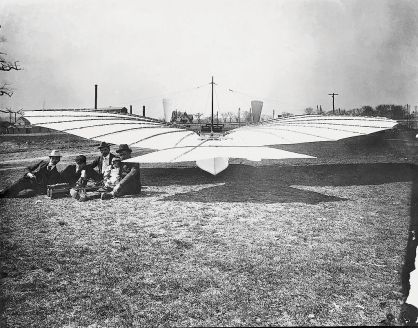
Not well-known at all is Gustave Weißkopf, a German who emigrated to the U.S., where he became Whitehead. The Bridgeport Sunday Herald local newspaper reported the flight of his Number 21 monoplane on August 14, 1901, two and a half years before the Wright Brothers’ flight. See picture 33. It had no rudder, therefore could only fly straight, nor had it flaps on its wings. Rising or landing was caused by the engine thrust and when they turned it off the plane landed like a glider.
Authoritative source love arguing; however, any ingeneer can tell you that the Wright’s thing is a kite and the Whitehead’s an aeroplane. And any scientist with the smallest fibre of ethics in his body would not accept a trial which is not repeatable.
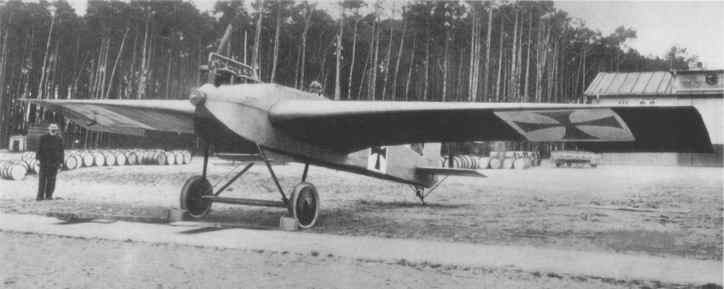
May this be as it is, the world’s first practical all-metal aircraft was the Junkers J 1, nicknamed the Blechesel (“Tin Donkey” or “Sheet Metal Donkey”), picture 34. It was flown on 12 December 1915, only 14 years after the Whitehead’s flight.
All-metal planes already applied the same principles of aerodynamics we still use and depend on today. The mechanical designs looked already very much like ours. What started it all? Allow me to reach back in time just a bit further.
Industrialisation

The initial trigger for all motorised vehicles was the onset of the industrial revolution, which can be dated from the early to mid-nineteenth century. What ignited this radical change in human life and our planet?
It was the availability of production machines with unremitting power. Moved by steam engines, they were hundred and thousand of times stronger than human beings. Until then, horses had been one of the strongest movers; this is why the power of engines was measured in horsepower.
Picture 35 shows an early steam engine with the flywheel on the left and a vertical cylinder to the right. The transmission belt would be mounted onto the flywheel. The engine would be in a separate room for noise and heat.

Factories for the mass production of goods were built, and their owners wanted to utilise their equipment (investment) for as long as possible, not only during daylight. In those days, people needed to feed and operate machines, and human beings need light to see. Gas was too expensive for lighting.
In their search for cheap, efficient lamp fuel, researchers found a use for the black stuff, which occasionally polluted the water when they drilled new water wells, oil.
In 1852, Abraham Gessner received a patent for Kerosene and its refining process. The demand for Kerosene was rising, and the accidental finds of oil when it was polluting water wells were not sufficient to satisfy the need.
In the late 1850th, the first drilling for oil started. Initially in Germany (because there most of the polluted water wells had occurred) and later in the USA, Pennsylvania. So far so good, but Kerosene as a fuel for lamps would not have caused modern civilisation to depend entirely on petroleum.
§
The real driving forces behind the increase in oil usage were the money people. 1870 Rockefeller got involved. It is a universal and old marketing principle, explaining to us: “Business grows when you sell more of what you have.”
There was plenty of oil in the ground; it was dirt cheap (cheap dirt); often it squirted out by itself once the hole was drilled. And there was so much more than was needed for lamp fuel. From a financier’s viewpoint, there was an unused commodity laying around, dirt cheap, begging to make money with it.
And another (bad) marketing rule is: “If there is no market need, create one!” What needed to be created was a dependency of people on oil. Directly, this was not possible. At the time, people didn’t need oil. There is no problem, which needs to be alleviated.
A new range of products was needed, which people would irresistibly desire. AND those products would need petroleum for their functioning. It is an indirect dependency. You don’t need it directly, but if you want to use your new toy, then you need petroleum.
§
Let me explain: Today, our whole world has been set up in a way requiring us to have transport. This had not always been like this. It is hard to imagine getting around without a car. The car needs petrol, we need petrol.
About one and a half centuries ago, an artificial need was created and with it an extensive market for the cheap dirt in the ground.
Just in time, Nicolas Otto started building the first useful four‑cylinder combustion engine, used mainly in cars. And twenty-five years later we had motor-propelled aircraft. Shortly after, during the First World War (1914 – 1918), plenty of new petrol-dependent vehicles were developed and built, trucks and fighter planes, and yet another new product, the tank.
The need for petroleum sky-rocketed. Who had sponsored and invested significant sums into engine development for it to be realised faster? And who made money when selling fuel? The name starts with ‘R’. For sure this is no coincidence. And people got killed. Oops!
§
Just a small sidestep to introduce you to another application of petroleum. Again around the mid-eighteen hundred, Justus von Liebig and Augustus von Hoffmann defined and established modern, organic chemistry, the chemistry of hydrocarbon. Based on what? You guessed correctly, petroleum.
In 1860, the production of synthetic fabric dye started, requiring as its main base material Aniline, made from petroleum. From this small start, the pharmaceutical, pesticides (what’s right for one, kills another) and plastics industry has grown.
Look at the big companies, Du Pont (producer of Nylon and Rayon), Hoechst (most significant producer of dye pigment), Bayer (producer of Aspirin, synthetic rubber and Dynamite) and BASF (most extensive range of dyes). (What is it about dyes?)
When the latter three merged in 1925, they became the largest company in the world. They all started with making pigments for dyes. Wow, another runner for the use of petroleum.
All this happened within 10 years. Without petroleum only a few of us would have cars powered by steam engines, we would go to the herbalist for medicine, and there would be no bouncy soles on our sneakers. And no television and computers and most probably I would not write this story. Oops. Is there a benefit to me, writing this?
§
In 1995 the worldwide consumption of petroleum was 25 billion barrels, and its production requires about twice the amount of crude oil. (Has anyone asked where the waste goes? The 25 billion barrels, which are not turned into fuel?) Picture 36 shows the energy consumption using different resources.

The world crude oil production has quadrupled since 1950. Some measure energy consumption in British thermal unit (Btu or BTU), a unit of work. It is the amount of work needed to raise the temperature of one pound of water by one degree Fahrenheit. This is the unit applied to picture 36.
Most people measure work in kilowatt (kW). Unfortunately, I can’t tell you the conversion, since the word quadrillion means two different numbers: either 1,000,000,000,000,000 in the so-called short scale or in the long scale it is 1,000,000,000,000,000,000,000,000… 15 zeros in the first number and 24 in the latter, or the English speakers against the rest of the world, respectively? I am not joking! See Wikipedia.
At least the graph gives you a trend, no matter what the measure of unit.
After this time, it slowed down (thanks to the greens, or what else) and when the Arabs realised???, their oil resources were finite, but since then the increase has been accelerating. And silly me had thought we had to slow down and make oil as long as possible.
§
Let’s return to flying. By 1860 to 70, efficient motors, fuelled by kerosene were available, but where did the glider originate? What was its history? I told you earlier about the dramatically unsuccessful attempts of mankind trying to fly. After all those tragedies, why start again? To find another application for fuel, to sell fuel.
The Race to Flying
In the early eighteen hundred, the first research team for flying science was established on the hillsides outside Darmstadt, Germany. They already had a wind tunnel. Third-generation research team member Otto Lilienthal invented the curved wing profile as we have it today. Remember Bernoulli’s principle (1700-1782)? In 1891 Otto performed his first successful (controlled) flight. Scientific research takes time, and it will find an answer. Luck is incidental and may never come. Over 2000 successful flights followed until he died in a crash in 1896.
This is the origin of the proverbial phrase: “They always come down.” Before his abrupt end, Lilienthal had been in the process of mounting one of Otto’s motors in his glider. Percy Pilcher, another successful glider designer, had his fatal fall in 1899.
I just read, that in 1977 someone flew a pedal‑driven plane over a distance of over 2 kilometres. Were you aware of this? Why would not everyone get one of those things? What’s the secrecy about it? How is this related to aeroplanes apparently not flying? I still insist: it is highly improbable.
As I said, for four million years everything was ok. Suddenly the pressure, the race was on; the run for finding more applications using petroleum and more and more it, because of one greedy person, Rockefeller. In the USA, the pressure was the highest, because Rockefeller was American and he owned the most petroleum resources at the time.
He had founded and funded a competition for building and flying – flying machines. Everyone wanted a slice of the cake, meaning being part of the game, the gamble. Most of the American gunghos had no scientific training. Sooner or later they crashed. No worries, there were always more to follow.
§
The main difference between the American and European designs was, that the Europeans used well-developed gliders, which could fly without an engine and manoeuvred well. The motor was used as an add‑on to prolong the flight (glide). The Americans used the principle of the kite, which had no technical history for steering means.
Three years after the Whitehead’s plane which had no rudder and could only fly straight, the Frenchman Louis Bleriot applied Lilienthal’s design principles and built the first steerable, motor-propelled aircraft and crossed with it the Channel in 1904, only a few months after the Wright’s so‑called flight (non-steerable, short hop, just a few meters above ground).
§
Successful investors are patient and let others carry out the job of taking the risk. It is a numbers game, where the increase in numbers of people trying to fly and the risk of investing money into this industry is reverse proportional. An investor just needs to wait. How to accelerate progress? You sponsor a competition, and you set up research grants. How generous and humanitarian is this?
Unexpected Assistance
Do you believe in guardian angels? Would a guardian angel try to prevent you from climbing into a contraption, if you are convinced of its flying capabilities? And when you, against all common sense, attempt to fly it? What do you think?

Guardian angel would try to prevent you from entering into this venture, but there is free will. And once you jumped off the edge, your crashing to death was inevitable. During the late eighteen hundred, more and more people attempted this ridiculous undertaking, and guardian angels became very anxious.
Therefore, they ganged up, and when the Wright brothers accomplished their pathetic bounce, their guardian angels had gathered a few friends, and with combined forces, they kept the apparatus in the air for a few short moments. Their real cause was to prevent the brothers from killing themselves.
They hoped that once the brothers had proven the flying capability of their contraption, they would be satisfied and let it be. This was, how it happened, really. It all makes sense, doesn’t it? Unfortunately, this kind deed inaugurated the dilemma of flying.
Because it worked once, the number of people trying to fly too increased drastically. This much about seeing is believing. And I tell you, it needed a lot of dashing here and there in the realms of guardian angels.
Picture 37 shows a tired Guardian Angel, you wonder why she is tired? Gradually they realised the calamity they had gotten themselves into. I just wonder: should they not have known better about human behaviour? Perhaps, they just could not help it; after all, they are determined to protect us.
In the end, it was not only the greed of the petroleum producers, which accelerated aeroplane development and made it succeed but the relentless effort of the guardian angels who kept on holding them in the air. Having a broader view of things, and changing one’s viewpoint often explains mysterious events.
By the way, once cars began to speed up, guardian angels were required to keep them on the road and prevent them from continually colliding. This dilemma initiated the saying: “Don’t drive faster than your guardian angel can fly”.
§
Allow me a little sidetrack. The information processing speed of the human brain is just fast enough to control events proceeding at velocities below 30 km/hr, or about 8 m/sec. Above this speed we hardly can see what’s happening, we only react, there is no time utilising the brain. The information we process the fastest is the recognition of faces. It takes about one-third of a second to recognise a familiar face.
At recognition speed, the fastest processing speed of the brain, when we travel at 30km/h, we would still move another 2.5m before we react after recognising an interference. This would be 5m at 60km/h, under consideration of top reaction performance.
For analysing a situation, most people can hold in their working memory (RAM) between five and nine chunks of information. Let’s assume a case, where five criteria are needed to be processed to arrive at an appropriate conclusion. Only for their recognition alone (not counting for processing), it would require 1.5sec or 12m of travel at 30km/hr.
Adding the time for processing, it starts making sense to keep a 3sec distance to the vehicle in front. At 30 km/hr, this would equate to 24m or 48m at 60 km/hr. And who keeps such a distance? If you would your guardian angel would be very grateful.
In typical situations, one guardian angel is provided per soul entering a human body. Most of those, living in the so-called modern, industrial, consumer civilisation (is there anything civil about it?) need more than one guardian angel.
Where do they come from? In some urgent situations, they would leave behind children and the elderly as well as those living in countries not partaking in our form of civilisation, who do not expose themselves to such ridiculous activities.
Advancing Dilemma
Back to aeroplanes. In early aircraft designs, the proportion of wing area and weight… the load and number of passengers, was in a manageable ratio. The available guardian angels would find space under the wings and fuselage and could hold the plane in the air.
However, modern aircraft, the Jumbo was the first, had proportionally much smaller wings, there was not enough space for the guardian angels any longer. Here is the story behind this tragedy.
When the Jumbo was designed the guardian angels frantically supervised the ingeneers and fed them with the right ideas. This was their way of keeping their workload manageable.
However, on one particular day, due to car races happening all over the planet, there was a shortage of angels on staff, with the aircraft ingeneers.
Unfortunately, this was the day when they designed the wings. When a guardian angel rushed to the drawing board of this particular ingeneer, he could only gasp, “This is a super-critical wing.”
And guess what they called it? A super-critical wing. Super-critical, the guardian angels called it this because they could not fit enough angels under it.
Allow me just for a moment to refer back to the tank in the wing paragraph. Can you see now, why wings don’t ignite or fall off?
§
We spend a lot of time trying to find out why aeroplanes crash. Often we never figure it out. Years ago, they introduced the flight recorder, which is stored in an ultra-safe box (Black Box) at the rear end of the plane, because there is the safest place. And still, most often the recorded data do not make sense.
What can be done? In a way, the guardian angels are to blame for misjudging humans’ behaviour. They should have known better. If you would be their boss, what action would you suggest? The guardian angels would not interfere; they care too much, this is the reason why they have done what they have done.
§
Humans would never come to their senses, have they any left? Maybe it’s time for big action. The most eminent solution coming from divine guidance would be: “Let them run out of petroleum.”
It was the central cause of the whole disaster. A comment I read recently, says it quite gently: “Petroleum will probably no longer be a common commercial material by the mid-21st century.”
I was searching the net… there are no charts available. I found:
World energy consumption has more than tripled since 1965
Fossil fuel production has increased twenty-fold from 1980 to 2006
Meaning, we have only thirty-five years or a little more to go. Will it last for this long? It does not matter that much. Indeed, we can say, fossil fuel is coming to an end. And then, what?
It took us only fifty years to set us up for this current civilised lifestyle, and we ended up being entirely dependent on petroleum. When are we going to start developing technologies capable of replacing petroleum as fuel, material and pharmaceuticals? Should we not have already started designing and building products, which are independent of fossil fuels?
We can argue about the time period, but, petroleum is available only in a finite quantity. There will be a time of adjustment to the “after fossil fuel era”, but after, things will brighten up again.
When will this time of adjustment begin? The start of developing technologies, which are capable of replacing petrol. When will this be?
§
Can aeroplanes fly? At this point, you would surely agree with me, we have many more reasons to answer with a distinct “No” than all those prominent scientists trying to make us believe: “Bumblebees and dragonflies can’t fly.”
Even a child would dispute the latter comment, but indeed doubt any aircraft lifting off the ground. However, taking into account our latest findings, we could answer more leniently: “Not by themselves, they need the help of guardian angels.”
Magic
As a final point, allow me to introduce you to the world of magic. In my childhood days, when only some privileged had television, (they didn’t have tele‑vision, they had a television set), we used to go to interact with each other and occasionally, we went to the movies and the circus. I always felt strange about the acts including animals.
I had no idea, how these animals lived in their natural habitat; nevertheless, it still felt strange. However, the acrobats were excellent; the clowns were better but the most I was fascinated by the magicians.
There was one occasion remaining stored in my memories when I volunteered as the magician’s assistant. He asked me to observe him carefully because after his demonstration it would be my turn to perform the trick.
First, the magician showed everyone a small red ball of about 3 centimetres in diameter. After he had placed it on the fingertips of his left hand, he covered the ball and his hand with a silky black cloth. While circling the whole arrangement with his magic wand, he said the magic words: Abracadabra, lifted the fabric and the ball had disappeared.
After the applause had calmed, he reached behind my ear and there it was back in his hand again. People applauded even more. I was stunned in quiet amazement.
I had observed him with total concentration. I was convinced, that I had not missed one part of the sequence. I was absolutely confident, I could repeat every step exactly the way he had shown it to me (never mind the audience). I was totally free of any doubt, a child does not ask why it believes and therefore knows.
I followed the procedure to the minutest detail. When I said the magic words, I felt a tingling flowing all through my body; I quivered and felt hot from excitement.
But alas, when I lifted the cloth the ball was still there. The audience laughed, which irritated me utterly because I could not understand why they would. I had tried it for the first time, I gave it a shot, and for some unknown reason, it did not work. Big deal.
Kindly the magician suggested: “Let me help you.” I repeated the procedure, only this time, he held my hand under the cloth. When I said the magic formula, an abated shriek escaped my lips when I felt the ball being ripped away from my fingertips. Where had it gone? I was awe-stricken.
This time they applauded, but I was not impressed. Was this all they could do at a moment of real magic? Clap their hands and make noise? Why were they not awestruck to silence, like me? This time the magician made the ball reappear from behind the ear of a person sitting in the nearby audience.
How it got there, I had no idea. The magician thanked me for my help. As I walked back to my seat, an uneasy feeling stirred inside me. Even after several days, several questions nagged me. What had really been going on? Had I experienced real magic? It must have been, but I was never quite sure.
§
By the way, found on an ancient Sumerian tablet from the 4th millennium BC, was this diminishing spell, a command: Abrada Ka Dabra meaning perish like the word!… when a word has been said, it perishes and according to the spell, so does the item in focus. There are many different spellings and many different opinions. Derived from Aramaic/Hebrew language, (3000 years old) it means I create as I speak! The meaning is powerful, like: It happens as I command.
Either way, 6 or 3 thousand years or whatever etymological origin, I ask you: If something is apparently this useless, like a magic spell, why would it survive the decay of time, for thousand years?
I have learned by now to leave things as they are, and allow magic to be, which is hard for an ingeneer.
§
This much I found out. Magicians, when talking about their tricks, this does not happen very often, they divide them into three parts. The Pledge: at this time the magic trick is proposed, and its impossibility is demonstrated. “I am going to make the red ball disappear.”
And you demonstrate it is dense, with no strings attached to the ball and you pull back your sleeves. Neither is there a double floor, nor mirrors.
The second part is called the Turn. Here the trick is performed. To the surprise of everyone, the red ball is gone. And you prove, it is not there, where people expect it to be.
In the final part, which is the Prestige, the trick is reversed. The red ball re‑occurs; maybe into the hat or somewhere else.
§
And how would this apply to an aircraft leaving the ground? I think the Red Ball trick is equivalent to this show. Let’s assume no one in your audience has ever seen an aircraft. In the pledge you propose, this gigantic metal thing would lift off the ground by itself, with no strings attached and fly in a controlled way. Of course, no one believes you.
At the beginning of the turn, you say your magic words and lo and behold with a lot of noise the machine rises into the air does a few circles and lands again. Everyone goes ooh and ah. Roaring applause. You let a volunteer try, and they have no success. And sure, with your assistance, the plane flies again.
A saying among magicians: “The secret of a trick is worth nothing, the value lies in how you apply it.” And therefore, they fly; only a few know the secret, but it makes aeroplanes fly, and there is a lot of value in flying, for some.
Drawing this essay to a close, allow me to recall a thought, phrased in the mid-seventeenth century by the French philosopher, mathematician, and physicist Blaise Pascal: If the thrown stone had consciousness it would say:
I fly because I want
FINALE
Without any doubt, with the evidence provided: “Aeroplanes can’t fly.” QED… quod erat demonstrandum, meaning “which is what had to be proven” or if you prefer the original Greek version ΟΕΔ… ὅπερ ἔδει δεῖξαι, meaning more precisely: “The very thing it (this paper) was required to have shown.”
We have derived and gained some understanding of what actually keeps them in the air. We investigated the reasons why some parties may want to keep this information confidential. They obtain a lot of value from this magic’s secret through knowing it but mainly from “…what they are doing with it”.
Can they be stopped? There would be many reasons for this, the least would be the protection of our dwindling oil reserves, the leftover, we could use better for more essential needs, such as medicine and efficient energy production. But this would be a big task, which I believe will solve itself, or be brought to an end by someone who is in charge of our planet’s energy balance.
Let’s assume some of us will survive all the lurking non-water tsunamis such as the oil crisis, global warming, pollution of air, water and food, rampaging virus and bacterial infections, suffocation in our own waste and another biggie: nuclear waste.
How could we hinder it from happening again? Preventing that, we just slide into the same dilemma, only a few hundred years in the future? After a short stone age, maybe?
It will be only short if we can preserve our real knowledge for those living in this future. How could this be achieved? As far as I know, all we know today is recorded on digital, laser and electronic storage media. But if we don’t have computers and no electricity, how could those data be read or deciphered? Is it time to carve our essential knowledge on stone tablets again? Let’s begin.
Oil needed millions of years to be created. And hopefully, we won’t find something else, causing the same disastrous result.
What to do? Start asking questions! Look at the obvious, the typical picture of our world and try to look behind it. How is it attached to the wall of belief and illusion? What is its backing? Who has put a frame around it, decided on its content, the limit of what is shown … to us, … possible for us to perceive? Questions, not asked by many, because most believe that what they see is all there is and take it as reality.
Look at things around you and observe, investigate and scrutinise. What is their perceived value and ask whether this is their real value? Are you free to look, to ask? And if not, who is taking your freedom away?
§
My essay is meant to be a pointer, an example setter for what to look for and what to ask. Not necessarily to prove that aeroplanes can’t fly. I want to ask you: “Would you have asked some of the questions I raised in this paper and explored their possible answers? If your answer were yes, I would ask you why. And if your answer were no, I will ask you why not.
Ω
